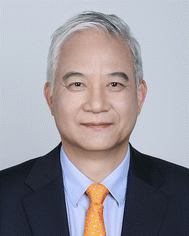Introduction to materials chemistry of fluorescence bioimaging
Sijie
Chen
 *ab,
Tony D.
James
*ab,
Tony D.
James
 *cd,
Apurba Lal
Koner
*cd,
Apurba Lal
Koner
 *e and
Ben Zhong
Tang
*f
*e and
Ben Zhong
Tang
*f
aSchool of Life Sciences, The Chinese University of Hong Kong, Shatin, New Territories, Hong Kong 999077, China. E-mail: sijie.chen@cuhk.edu.hk
bMing Wai Lau Centre for Reparative Medicine, Department of Neuroscience, Karolinska Institutet, Stockholm, Sweden
cDepartment of Chemistry, University of Bath, Bath, BA2 7AY, UK. E-mail: t.d.james@bath.ac.uk
dSchool of Chemistry and Chemical Engineering, Henan Normal University, Xinxiang 453007, China
eBionanotechnology Laboratory, Department of Chemistry, Indian Institute of Science Education and Research Bhopal, Bhopal By-pass Road, Bhauri, Bhopal 462066, Madhya Pradesh, India. E-mail: akoner@iiserb.ac.in
fSchool of Science and Engineering, Shenzhen Institute of Aggregate Science and Technology, The Chinese University of Hong Kong, Shenzhen (CUHK-Shenzhen), Shenzhen, 518172, China. E-mail: tangbenz@cuhk.edu.cn
Fluorescence imaging is a predominant method employed in biological and biomedical research. This powerful technique utilises fluorescent probes that emit light upon excitation, enabling non-invasive and real-time observation of specific targets within the living system. It assists researchers in localising specific proteins in tissue, visualising subcellular structures, studying cell organisation, monitoring the bio-microenvironment, and even conducting image-guided surgery. From fundamental biological studies to biomedical applications, fluorescence bioimaging continues to facilitate a more comprehensive understanding of the complex biological world and provide us with powerful tools for disease diagnosis or treatment. This themed collection aims to provide a platform for recent developments in this rapidly evolving field of fluorescence bioimaging.
Featured in this collection are a wide range of novel and innovative sensors and probes. Liu, Fang et al. (https://doi.org/10.1039/D4TB00400K) present three aniline-based squaraines for two-photon fluorescence bioimaging in plant cells, while Yin et al. (https://doi.org/10.1039/D4TB00478G) report a fluorescent probe for real-time lysosomal imaging of cysteine. del Mercato et al. (https://doi.org/10.1039/D4TB01047G) develop a sensor for the ratiometric optical detection of potassium ions in cellular processes, while Yoon, Liu et al. (https://doi.org/10.1039/D4TB00934G) present a naphthalene-based fluorescent probe that detects mercury ions via excimer formation. Peng et al. (https://doi.org/10.1039/D4TB01462F) exploit a urea bond cleavage reaction for fluorescent imaging of nitric oxide in cells, and Li, Wang et al. (https://doi.org/10.1039/D4TB01828A) dynamically image hydrogen peroxide in serotonergic neurons using a small-molecule fluorescent probe. To give just two more examples from many in this collection, Klausen, Bradley et al. (https://doi.org/10.1039/D4TB01786B) synthesise a tri-branched fluorogenic probe with binding ligands for the detection of specific Gram-negative bacteria, and Pérez-García et al. (https://doi.org/10.1039/D4TB01859A) functionalise silicon oxide microchips with BODIPY probes for sensing glutathione in living cells.
As well as sensing applications, the collection features many materials with therapeutic functions. Kwok, Lam, Tang et al. (https://doi.org/10.1039/D4TB01175A) synthesise an aggregation-induced-emission-based photosensitiser able to generate type I and type II reactive oxygen species, while Wang, Yu, Yu et al. (https://doi.org/10.1039/D4TB01650E) report a H2O2-responsive BODIPY photosensitiser for imaging tumors and type I/II photodynamic therapy. Jiang, Hu et al. (https://doi.org/10.1039/D4TB01840K) demonstrate the antibacterial efficacy of a supramolecular system based on guanidiniocarbonyl-pyrrole-functionalised cucurbit[7]uril, and Zhao et al. (https://doi.org/10.1039/D4TB02372B) utilise a donor–π–acceptor structure for antimicrobial therapy in wounds. Dutta, Koner et al. (https://doi.org/10.1039/D4TB00572D) develop an NBD-based small-molecule probe for understanding ER stress and ER-Golgi communication. Iyer et al. (https://doi.org/10.1039/D4TB01740D) report a small molecule with the ability to inhibit amyloid beta fibril formation, showing promise in the fight against Alzheimer’s disease.
The collection also highlights new mechanistic insights and design principles in fluorescent materials. Huang and Nishimura (https://doi.org/10.1039/D4TB01745E) find new insights in the effect of hydroxide groups on excited-state intermolecular proton transfer to discern between specific monosaccharides, while Lou et al. (https://doi.org/10.1039/D4TB01801J) show that distinguishing the cis and trans isomers of peptide-based probes can enhance transmembrane protein recognition. Isomerism engineering is used by Li, Zhao et al. (https://doi.org/10.1039/D4TB01847H) to tailor the properties of aggregation-induced emission luminogens with a cyano group, and by Ni et al. (https://doi.org/10.1039/D4TB01617C) to optimise a coumarin-based fluorophore for H2S sensing. Gunnlaugsson, Henwood et al. (https://doi.org/10.1039/D4TB01905A) show that the number and positioning of triphenylamino moieties greatly affect the optoelectronic and aggregation properties of aromatic imides.
As well as cutting-edge primary research, progress in the field is showcased by several insightful reviews. Mishra and Mishra (https://doi.org/10.1039/D4TB01960A) summarise recent developments in the design and application of enzyme-response fluorescent probes for disease diagnostics, while Pal (https://doi.org/10.1039/D4TB01858C) highlights the contribution of DNA-based fluorogenic tension sensors to the field of mechanobiology. You, Chen et al. (https://doi.org/10.1039/D4TB01440E) review aggregation-induced emission probes for imaging organelles under oxidative stress, while Smith et al. (https://doi.org/10.1039/D4TB01281J) compare methods of steric protection for enhancing the performance of near-infrared fluorescent dyes. Finally, Dong, Zeng et al. (https://doi.org/10.1039/D4TB01835D) discuss how artificial intelligence is guiding the design of subcellular fluorescent probes.
This themed collection is dedicated to showcasing the latest advancements in all aspects of materials chemistry for application in fluorescence bioimaging. By bringing together cutting-edge research, from mechanistic insights for understanding fluorescence bioimaging to materials design of new innovative probes for therapeutic applications, the collection seeks to give a broad overview into interdisciplinary collaborations focusing on advancing fluorescence bioimaging techniques towards practical applications. We are pleased to highlight such exciting and timely innovations and hope this collection helps in inspiring future research.
| This journal is © The Royal Society of Chemistry 2025 |




